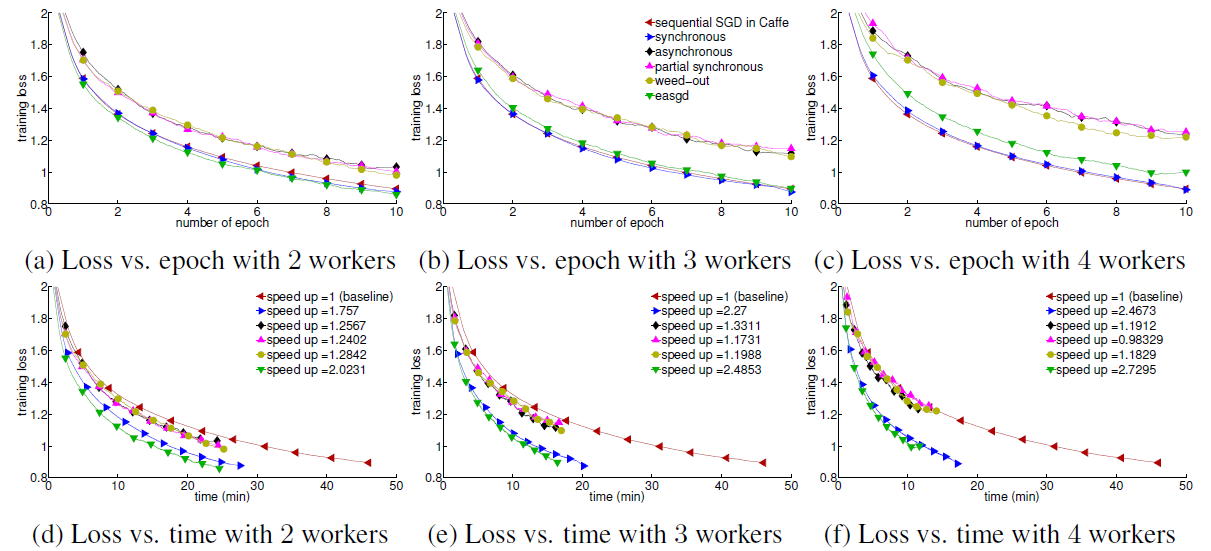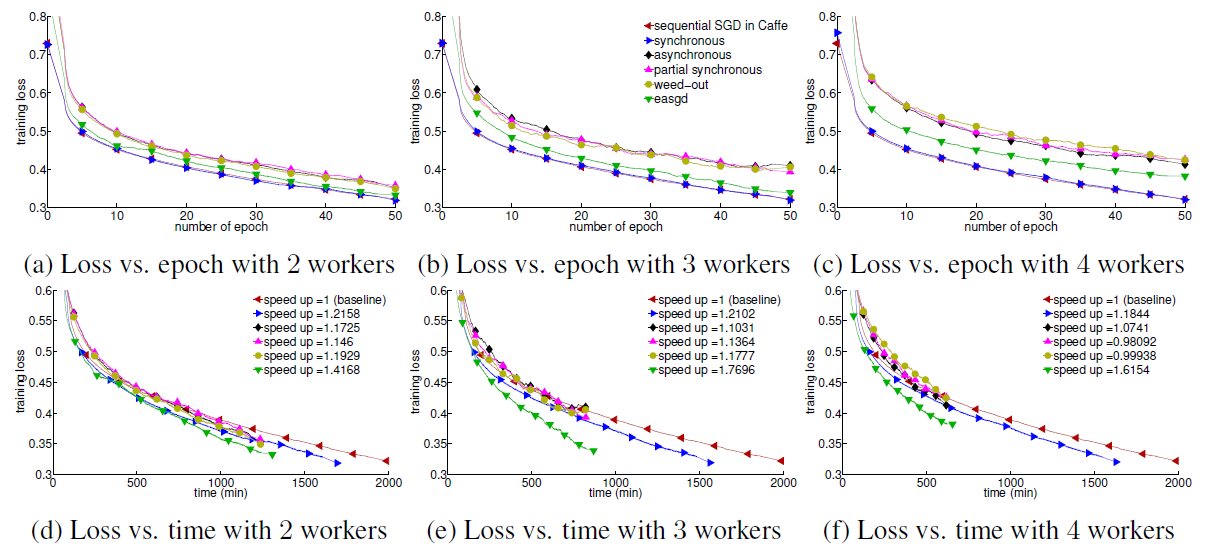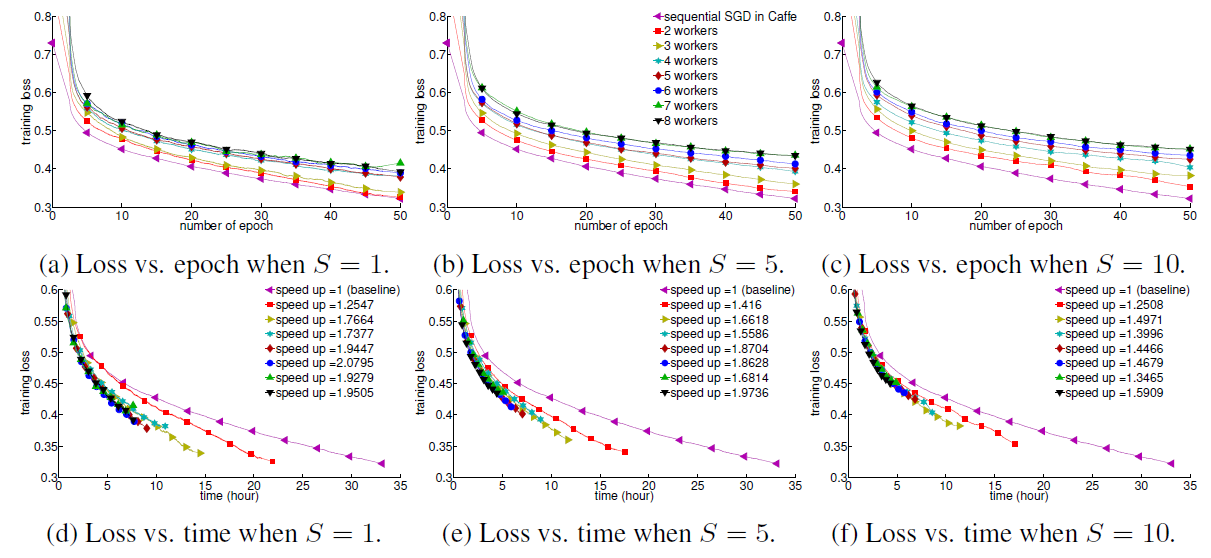Convolutional Neural Networks (CNNs) have achieved breakthrough results on many machine learning tasks. However, training CNNs is computationally intensive. When the size of training data is large and the depth of CNNs is high, as typically required for attaining high classification accuracy, training a model can take days and even weeks. So we propose SpeeDO (for Open DEEP learning System in backward order), a deep learning system designed for off-the-shelf hardwares. SpeeDO can be easily deployed, scaled and maintained in a cloud environment, such as AWS EC2 cloud, Google GCE, and Microsoft Azure.
In our implement, we support 5 distributed SGD models to speed up the training:
- Synchronous SGD
- Asynchronous SGD
- Partially Synchronous SGD
- Weed-Out SGD
- Elastic Averaging SGD
Please cite SpeeDO in your publications if it helps your research:
@article{zhengspeedo,
title={SpeeDO: Parallelizing Stochastic Gradient Descent for Deep Convolutional Neural Network},
author={Zheng, Zhongyang and Jiang, Wenrui and Wu, Gang and Chang, Edward Y}
}
SpeeDO takes advantage of many existing solutions in the open-source community, data flow of SpeeDO:
SpeeDO mainly contains these components:
These components denote what we need to deploy before the distributed training.
- JDK 1.7+
- Redis Server
- Ubuntu 12.04+ (not test on other linux os family)
- Network connection: You need to connect to maven and ivy repositories when compiling the demo
SpeeDO is running in Master-Slaves(Worker) archiecture. To avoid manual process in running, and distribute input data in Master and worker nodes, we can use YARN and HDFS. In below, we provides the instruction to run SpeeDO for both scenarios.
| Configuration | YARN present | HDFS present |
|---|---|---|
| A | N | N |
| B | Y | Y |
NOTE
i. YARN is used for nodes resource scheduling. If YARN is not present, we can run our Master , and Worker process manually.
ii. HDFS is used for storing training data and network definition of caffe. If HDFS is not present, we can use shared-files system (like NFS ) or manually copying these files to each nodes.
We provide the steps to run configuration A and B here:
- For configuration A, we manually deploy and run on all nodes.
- For configuration B, we use cloudera (offering us both YARN and HDFS) to deploy and run SpeeDO.
We provides TWO methods here: 1) Docker , 2) Manual ( step by step)
##1. Quick Start ( via Docker )
Pull the speedo image ( bundled with caffe and all its dependencies libraries):
docker pull obdg/speedo:latestThe following example will run 1000 iterations asynchronously using 1 Master with 3 workers ( 4 cluster nodes )
Launch master container on your master node (in default Async model with 3 workers):
docker run -d --name=speedo-master --net=host obdg/speedoOr run master actor in Easgd model with 3 workers
docker run -d --name=speedo-master --net=host obdg/speedo master <master-address> 3 --test 0 --maxIter 1000 --movingRate 0.5Please replaces master-address with master node's ip
NOTE Redis service will be started automatically when launching master container
Launch 3 worker containers on different worker nodes:
docker run -d --name=speedo-worker --net=host obdg/speedo worker <master-address> <worker-address>Please replaces master-address with master node's ip, and worker-address with the current worker node's ip
##2. Manually ( Step by Step )
Install at each nodes ( Master and Worker)
- JDK 1.7+
- Redis Server
- Clone SpeeDO and Caffe source from our github repo
Please use
git clone --recursive git@github.com/obdg/speedo.git # SpeeDO and caffe
Install speedo/caffe and all its dependencies on each nodes , please refer to section A. Manually install on all cluster nodes from speedo/caffe install guide.
NOTE: We prefer to use datumfile format for SpeeDO ( see caffe-pullrequest-2193 ) instead of the default leveldb/lmdb format during training in Caffe to solve the memory usage problem ( refer to caffe-issues-1377).
The input data required by Caffe, including:
- solver definition
- network definition
- training datasets
- testing datasets
- mean values
In this example, let's train cifar10 dataset and generate training datasets and testing datasets in dataumfile format:
cd caffe
./data/cifar10/get_cifar10.sh # download cifar dataset
./examples/speedo/create_cifar10.sh # create protobuf file - in datumfile instead of leveldb/lmdb formatSolver definition, network definition and means values written in datumfile format for cifar10 is provided at examples/speedo.
If you want to manually produce these files, please follow the steps below. (Modify all paths in network definitions if needed ) :
sed -i "s/examples\/cifar10\/mean.binaryproto/mean.binaryproto/g" cifar10_full_train_test.prototxt
sed -i "s/examples\/cifar10\/cifar10_train_lmdb/cifar10_train_datumfile/g" cifar10_full_train_test.prototxt
sed -i "s/examples\/cifar10\/cifar10_test_lmdb/cifar10_test_datumfile/g" cifar10_full_train_test.prototxt
sed -i "s/backend: LMDB/backend: DATUMFILE/g" cifar10_full_train_test.prototxt
sed -i "17i\ rand_skip: 50000" cifar10_full_train_test.prototxt
sed -i "s/examples\/cifar10\/cifar10_full_train_test.prototxt/cifar10_full_train_test.prototxt/g" cifar10_full_solver.prototxtAt last, put the data in the same location(like /tmp/caffe/cifar10) on all Master and Workers node. You can do that by Ansible or just scp to the right location.
SpeeDO use Master + Worker archiecture for the distributed training (Please refer to our paper for the detail information). We need to start Master node and Worker node as below.
On each master and worker nodes, run
git clone git@github.com/obdg/speedo.git # if not done yet
cd speedo
./sbt akka:assemblyThe following example will run 1000 iterations asynchronously using 1 Master with 3 workers ( 4 cluster nodes ).
Launch master process on your master node:
JAVA_LIBRARY_PATH=$JAVA_LIBRARY_PATH:/usr/lib java -cp target/scala-2.11/SpeeDO-akka-1.0.jar -Xmx2G com.htc.speedo.akka.AkkaUtil --solver /absolute_path/to/cifar10_full_solver.prototxt --worker 3 --redis <redis-address> --test 500 --maxIter 1000 --host <master-address> 2> /dev/nullPlease replaces redis-address with the redis server location, and master-address with master node's ip/hostname.
This should output some thing like:
[INFO] [03/03/2016 15:07:41.626] [main] [Remoting] Starting remoting
[INFO] [03/03/2016 15:07:41.761] [main] [Remoting] Remoting started; listening on addresses :[akka.tcp://SpeeDO@cloud-master:56126]
[INFO] [03/03/2016 15:07:41.763] [main] [Remoting] Remoting now listens on addresses: [akka.tcp://SpeeDO@cloud-master:56126]
[INFO] [03/03/2016 15:07:41.777] [SpeeDO-akka.actor.default-dispatcher-3] [akka.tcp://SpeeDO@cloud-master:56126/user/host] Waiting for 3 workers to join.
Launch 3 workers process on worker nodes:
JAVA_LIBRARY_PATH=$JAVA_LIBRARY_PATH:/usr/lib java -cp target/scala-2.11/SpeeDO-akka-1.0.jar -Xmx2G com.htc.speedo.akka.AkkaUtil --host <worker-address> --master <masteractor-addr> 2> /dev/nullPlease replaces worker-address with worker's ip/hostname, and masteractor-addr with master actor address.
The format of master actor address is akka.tcp://SpeeDO@cloud-master:56126/user/host, where cloud-master is the hostname of master node, and 56126 is the TCP port listen by akka's actor. Since the port is random by default, the address can vary in different runs. You can also use fixed port by passing a --port <port> command line argument when start Master.
To try a cloudera solution for SpeeDO. Please refer Run SpeeDO on Yarn & HDFS Cluster
The Cifar10 dataset is used to validate all parallel implementations on a CPU cluster with four 8-core instances
Training GoogleNet on a GPU cluster for different parallel implementations
EASGD achieves the best speedup in our parallel implementations. And parameters of it have great impact for the speedup.
Copyright 2016 HTC Corporation
Licensed under the Apache License, Version 2.0: http://www.apache.org/licenses/LICENSE-2.0



